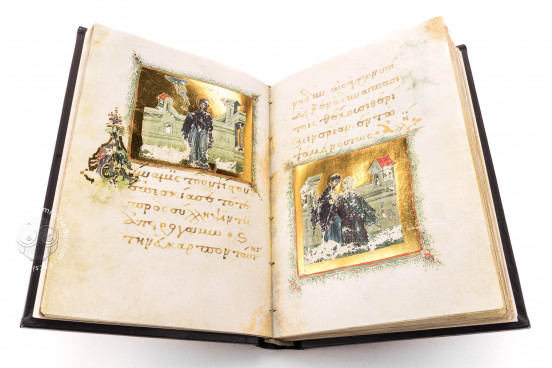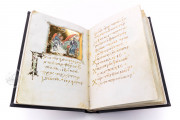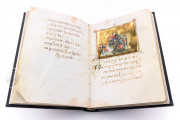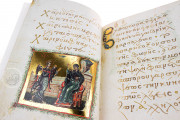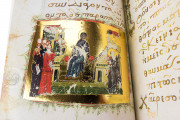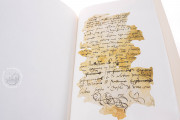The Akathistos to the Theotokos is a hymn of thanksgiving of particular historical importance. In addition to its variable position in the liturgical rite, the hymn was associated with the celebration of military victories, many of which were attributed to the miraculous intervention of the Virgin Mary.
Accompanied by refrains, the hymn is broken up into twenty-four stanzas, the initials of which form an alphabetical acrostic. The surviving pictorial tradition of the hymn is predominantly known in icons, textiles, and monumental frescoes dating from the twelfth century. The Moscow Akathistos is thus significant as one of only two manuscripts illustrating the beloved hymn.
Written entirely in a fine Greek calligraphic hand, the Moscow exemplar also includes an anthology of hymns following the Akathistos. Illustrating each stanza of the hymn, its twenty-three miniatures, and twenty-three figural initials are exclusively found in the pages dedicated to the Akathistos.
The miniatures are all framed and are on burnished gold grounds while the initials – composed of intertwined animals and vegetal motifs forming the bodies of the letters – are similarly on a gold ground shaped to the contours of the letters themselves.
Priming and Three Stages of Execution
The annotations of the copyist, blank pages, and changes in the layout demonstrate that the Moscow Akathistos was made in three separate stages of work. Before any of this was done the parchment was prepared in a unique manner: white lead primer was thickly applied to each sheet so that the hair and flesh sides of the parchment would look identical.
The first campaign of work encompasses the leaves including the Akathistos hymn, where it is clear that the copyist carefully laid out the text leaving space for the miniatures on the top and bottom halves of the pages.
Several leaves were removed after the completion of the hymn after which the two other sections follow. Although written by the same scribe, these two final parts feature a smaller script.
Spanning from ff. 35-61, the second stage of the manuscript features modest decoration of wavy lines with ornamental beads likely carried out by the scribe. Given the presence of the empty spaces throughout ff. 62-71, it appears that the third campaign was also meant to have a decoration that was never completed.
A Product of the Renowned Hodegon Scriptorium
The Moscow Akathistos was written by the leading patriarch of the Hodegon Scriptorium, the Hieromonk Joasaph. The τῶν Ὁδηγῶν in Costantinople was the premier monastery for anyone who wanted a luxury illuminated liturgical manuscript and became the center and namesake of the calligraphic archaizing script Hodegonstil in which all the illuminated manuscripts from the last century of the empire were copied. The script is very legible and clear and, to that end, is also characterized by its prevailing absence of abbreviations.
The first preserved work of Hieromonk Joasaph dates from 1360 and his prolific output is well-documented. Although the Moscow Akathistos bears no date, experts argue that the book was from the last phase of his work before his death in 1406, thus dating the codex to the very end of the fourteenth century.
Apographon John Rhosos
The Moscow Akathistos was restored in Italy in the second half of the fifteenth century by John Rhosos, a Greek copyist active in Venice and Rome. While working in the latter, he copied Greek manuscripts for none other than Cardinal Bessarion, along with Alessandro Farnese and Cardinal Francesco Gonzaga.
At this time, the book may have already been in Italian hands. It could have also been in the possession of recent Greek emigrants and would have thus reminded them of the holiest places in the recently captured city.
From Italy, the manuscript appears to have made its way back to Greece. The manuscript was sent from Mount Athos to the Czar Alexis Mikhailovič in the seventeenth century as a gift.
Binding description
The binding of the manuscript appears to date before the sixteenth century. It is composed of wooden boards covered with black stamped leather on the front and dark green leather on the rear and features copper bosses on both sides. It is clear that it was not the original binding since several of the leaves have been trimmed.
We have 1 facsimile edition of the manuscript "Moscow Akathistos": Akathistos de Moscú facsimile edition, published by AyN Ediciones, 2006
Request Info / Price

